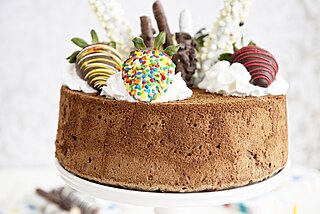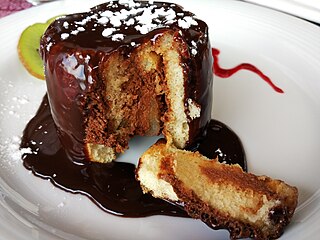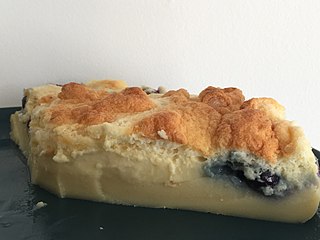
Dessert is a course that concludes a meal. The course consists of sweet foods, such as cake, biscuit, ice cream and possibly a beverage such as dessert wine and liqueur. Some cultures sweeten foods that are more commonly savory to create desserts. In some parts of the world there is no tradition of a dessert course to conclude a meal.

Cake is a flour confection made from flour, sugar, and other ingredients and is usually baked. In their oldest forms, cakes were modifications of bread, but cakes now cover a wide range of preparations that can be simple or elaborate and which share features with desserts such as pastries, meringues, custards, and pies.

Angel food cake, or angel cake, is a type of sponge cake made with egg whites, flour, and sugar. A whipping agent, such as cream of tartar, is commonly added. It differs from other cakes because it uses no butter. Its aerated texture comes from whipped egg white. Angel food cake originated in the United States and first became popular in the late 19th century. It gained its unique reputation along with its name due to its light and fluffy texture and white color.

Pound cake is a type of cake traditionally made with a pound of each of four ingredients: flour, butter, eggs, and sugar. Pound cakes are generally baked in either a loaf pan or a Bundt mold. They are sometimes served either dusted with powdered sugar, lightly glazed, or with a coat of icing.

Icing, or frosting, is a sweet, often creamy glaze made of sugar with a liquid, such as water or milk, that is often enriched with ingredients like butter, egg whites, cream cheese, or flavorings. It is used to coat or decorate baked goods, such as cakes. When it is used between layers of cake it is known as a filling.

Shortcake generally refers to a dessert with a crumbly scone-like texture. There are multiple variations of shortcake, most of which are served with fruit and cream. One of the most popular is strawberry shortcake, which is typically served with whipped cream. Other variations common in the UK are blackberry and clotted cream shortcake and lemon berry shortcake, which is served with lemon curd in place of cream.

Gooey butter cake is a type of cake traditionally made in St. Louis, Missouri. It is a flat and dense cake made with wheat cake flour, butter, sugar, and eggs, typically near an inch tall, and dusted with powdered sugar. While sweet and rich, it is somewhat firm, and is able to be cut into pieces similarly to a brownie. Gooey butter cake is generally served as a type of coffee cake and not as a formal dessert cake. There are two distinct variants of the cake: the original St. Louis, MO Bakers' gooey butter and a cream cheese and commercial yellow cake mix variant. The original St. Louis, MO Bakers' gooey butter is believed to have originated in the 1930s. It was made with a yeast-raised sweet dough on the bottom.

A mille-feuille, also known by the names Napoleon in North America, vanilla slice in the United Kingdom, and custard slice, is a French dessert made of puff pastry layered with pastry cream. Its modern form was influenced by improvements made by Marie-Antoine Carême.

Baumkuchen is a kind of spit cake from German cuisine. It is also a popular dessert in Japan. The characteristic rings that appear in its slices resemble tree rings, and give the cake its German name, Baumkuchen, which literally translates to "tree cake" or "log cake".

A layer cake or sandwich cake is a cake consisting of multiple stacked sheets of cake, held together by frosting or another type of filling, such as jam or other preserves. Most cake recipes can be adapted for layer cakes; butter cakes and sponge cakes are common choices. Frequently, the cake is covered with icing, but sometimes, the sides are left undecorated, so that the filling and the number of layers are visible.

Simnel cake is a fruitcake widely eaten in England, Ireland and other countries with patterns of migration from them, associated with Lent and Easter. It is distinguished by layers of almond paste or marzipan, typically one in the middle and one on top, and a set of eleven balls made of the same paste. It was originally made for the fourth Sunday in Lent, also known as Laetare Sunday, the Refreshment Sunday of Lent, Mothering Sunday, the Sunday of the Five Loaves, or Simnel Sunday; named after the cake. In the United Kingdom it is now commonly associated with Mothering Sunday and Easter Sunday.

A génoise, also known as Genoese cake or Genovese cake, is a French sponge cake named after the city of Genoa and associated with French cuisine. It was created by François Massialot in the late 17th century. Instead of using chemical leavening, air is suspended in the batter during mixing to provide volume.

A charlotte is a type of bread pudding that can be served hot or cold. It is also referred to as an "icebox cake". Bread, sponge cake, crumbs or biscuits/cookies are used to line a mold, which is then filled with a fruit puree or custard. The baked pudding could then be sprinkled with powdered sugar and glazed with a salamander, a red-hot iron plate attached to a long handle, though modern recipes would likely use more practical tools to achieve a similar effect.

Spekkoek is a type of Indonesian layer cake. It was developed during colonial times in the Dutch East Indies. The firm-textured cake is an Indo (Dutch-Indonesian) version of the European multi-layered spit cake. However it is not baked on a rotating spit, and contains a mix of Indonesian spices, such as cardamom, cinnamon, clove, mace and anise. The cake is made of flour and yolk and is rich in butter or margarine.
The following outline is provided as an overview of and topical guide to chocolate:

Sponge cake is a light cake made with eggs, flour and sugar, sometimes leavened with baking powder. Some sponge cakes do not contain egg yolks, like angel food cake, but most of them do. Sponge cakes, leavened with beaten eggs, originated during the Renaissance, possibly in Spain. The sponge cake is thought to be one of the first non-yeasted cakes, and the earliest attested sponge cake recipe in English is found in a book by the English poet Gervase Markham, The English Huswife, Containing the Inward and Outward Virtues Which Ought to Be in a Complete Woman (1615). Still, the cake was much more like a cracker: thin and crispy. Sponge cakes became the cake recognised today when bakers started using beaten eggs as a rising agent in the mid-18th century. The Victorian creation of baking powder by English food manufacturer Alfred Bird in 1843 allowed the addition of butter to the traditional sponge recipe, resulting in the creation of the Victoria sponge. Cakes are available in many flavours and have many recipes as well. Sponge cakes have become snack cakes via the Twinkie.

A spit cake is a European-styled cake made with layers of dough or batter deposited, one at a time, onto a tapered cylindrical rotating spit. The dough is baked by an open fire or a special oven, rotisserie-style. Generally, spit cakes are associated with celebrations such as weddings and Christmas. The spit can be dipped in a thin dough, or the dough can be poured or rolled on the spit.

A Lady Baltimore cake is an American white layer cake with fluffy frosting and a fruit and nut filling. The cake is believed to have been created in the Southern United States in the early 20th century, but its exact origins are disputed.

A gâteau magique is a French cake that forms three layers when the batter is baked. The bottom layer is custard, the middle layer is cream and the top layer is a sponge.
Amygdalopita is an almond cake in Greek cuisine made with ground almonds, flour, butter, eggs and pastry cream. It is one of the most common glyka tapsiou - dessert dishes like pies and breads baked in baking pans. Other common desserts of this style are galaktoboureko, karydopita and kadaifi.


















